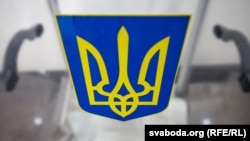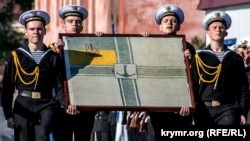Ukrainian President Volodymyr Zelenskiy hopes a proposed expansion of Ukraine’s famous blue-and-yellow national emblem -- the trident -- can be passed by parliament in time for the country’s 30th anniversary of independence.
Ukrainian President Volodymyr Zelenskiy said on June 29 that he is submitting to the Verkhovna Rada an “urgent” draft law that would update the design of Ukraine’s national emblem. If passed, the proposal would give Ukraine a more complex national emblem than the current yellow trident on a blue shield.
Ukraine seeks to join several countries that have two national emblems, with one serving as a kind of visual shorthand for a more elaborate "greater" symbol of statehood.
The design being put forward by Zelenskiy (pictured above) won a 2020 contest judged by a “professional jury” that included the creator of the trident currently used as Ukraine's state emblem. The design fulfills several requirements stipulated in the constitution, but some have called for tweaks to be made. Complaints include the Ukrainian flag appearing to be being stepped on and what appear to be socks being worn by an angel.
The Ukrainian president said on June 28 that "over the years, there have been many different competitions, disputes, quarrels, opinions, and visions” for the final design of the national emblem. He added: “This is normal. This is democracy. I think that in the year of the 30th anniversary of independence and the 25th anniversary of [Ukraine’s] constitution, we must finally put an end to this issue.”
The exact symbolism of the current trident is unclear, but its earliest known use dates to the rule of Volodymyr the Great, the ruler of Kievan Rus, from about 1,000 years ago.
In 1918, the trident symbol appeared as a national symbol for independent Ukraine during the country’s short-lived “People’s Republic” of 1917-20 before Ukraine was captured by Vladimir Lenin’s Bolsheviks and turned into a socialist republic of the Soviet Union.
During World War II, the trident reappeared as heraldry for Nazi-linked nationalist organizations who were fighting against the Soviets, including the notorious Auxiliary Police, who aided the Germans during their bloody occupation of Ukraine.
After Ukraine declared its independence from the Soviet Union in 1991, the hammer and sickle of the Ukrainian Soviet Socialist Republic was replaced with a “lesser” emblem of the yellow trident on a blue shield. A “greater” and more elaborate symbol still has not been agreed upon, despite several attempts.
Some Ukrainians believe that after 30 years of using the trident, the constitution's requirement for another symbol should be ignored. Historian Oleksandr Zinchenko told RFE/RL's Ukrainian Service that the trident is "one of the most original emblems on the planet. Why complicate it when we can instead retain its simple, vivid minimalism?"








